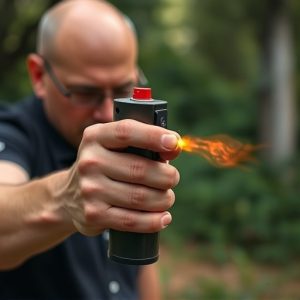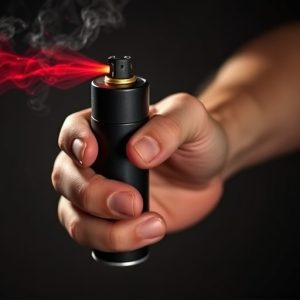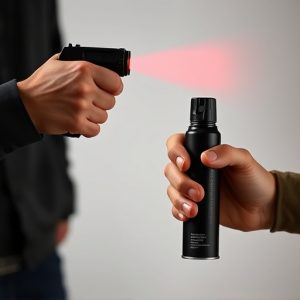Pepper Spray: Understanding and Treating Chemical Irritant Exposure
Immediate Care for Pepper Spray exposure involves several key steps:1. Remove contaminated clothing…….
Immediate Care for Pepper Spray exposure involves several key steps:
1. Remove contaminated clothing near eyes, nose, and mouth.
2. Rinse affected areas with clean water for at least 15 minutes to dilute the irritant.
3. Keep eyelids open while rinsing in case of eye contact.
4. Move to a well-ventilated area if respiratory distress occurs, seeking medical attention if breathing remains difficult.
5. Apply a cool compress for pain and swelling relief, staying calm to avoid further irritation.
Future trends focus on advanced, compact pepper spray designs with longer durations and eco-friendly alternatives while maintaining effectiveness for immediate care in dangerous situations.
“Uncovering the power of chemical irritants, specifically pepper spray, offers a critical layer of personal protection. This article delves into the science behind these potent substances, exploring their composition and effects. We provide essential insights on immediate care and treatment for pepper spray exposure, guiding readers through potential risks and safe practices.
Additionally, we examine the integration of pepper spray into personal protection devices, discussing safety measures and highlighting emerging trends that shape the future of self-defense.”
- Understanding Chemical Irritants: The Science Behind Pepper Spray
- Immediate Care and Treatment for Pepper Spray Exposure
- Incorporating Pepper Spray into Personal Protection Devices: Safety Measures and Future Trends
Understanding Chemical Irritants: The Science Behind Pepper Spray
Chemical irritants, like pepper spray, are designed to disrupt an attacker’s senses and provide time for escape or assistance. The active ingredient in pepper spray is capsaicin, a chemical compound derived from chili peppers. When exposed to the eyes or respiratory system, capsaicin stimulates nerve endings, causing intense irritation, coughing, tears, and difficulty breathing.
Immediate care after exposure to pepper spray is crucial. It involves thoroughly rinsing the affected areas with water for at least 15 minutes. In cases of eye contact, holding the affected eye open and gently irrigating it with clean water can help flush out the irritant. If inhaled, the individual should move to an area with fresh air immediately. Seeking medical attention is advised if symptoms persist or worsen, ensuring prompt relief and preventing potential long-term effects.
Immediate Care and Treatment for Pepper Spray Exposure
In the event of exposure to pepper spray, immediate care is crucial to mitigating the effects and ensuring swift recovery. If someone comes into contact with pepper spray, it’s essential to act promptly. Remove any contaminated clothing or accessories, taking special care around the eyes, nose, and mouth as these areas are most susceptible to irritation. Rinse the affected area with plenty of clean water for at least 15 minutes to dilute and wash away the irritant.
For eye exposure, hold the eyelids open and continue rinsing until any burning sensation subsides. If respiratory distress occurs, move the individual to a well-ventilated area or outdoors, and if they cannot breathe easily, seek medical attention immediately. Applying a cool compress to the face may provide some relief from pain and swelling. It’s important to stay calm and avoid excessive movement to prevent further irritation.
Incorporating Pepper Spray into Personal Protection Devices: Safety Measures and Future Trends
Incorporating pepper spray into personal protection devices has become a popular and effective strategy for self-defense. As a potent chemical irritant, pepper spray can temporarily disable an assailant by causing severe eye and respiratory distress. These devices are designed to provide individuals with an immediate means of care in potentially dangerous situations, allowing them to create distance from threats quickly.
Future trends in personal protection technology suggest innovative integrations of pepper spray into compact, discreet, and advanced devices. Researchers and manufacturers are exploring smarter designs that offer precise activation mechanisms, improved range, and longer-lasting effects while minimizing the risk of accidental deployment. Additionally, there is a growing focus on creating eco-friendly alternatives with reduced environmental impact without compromising effectiveness, ensuring immediate care for those in need while aligning with sustainability goals.
Pepper spray, a powerful chemical irritant, has become an essential component of personal protection devices. Understanding its science and immediate care protocols is crucial for effective usage and mitigating potential risks. As we look to the future, innovative trends in personal safety equipment, driven by advancements in chemistry and technology, promise to enhance our ability to protect ourselves against pepper spray and other irritants. Remember that proper training and adherence to safety measures are key when incorporating these devices into personal protection strategies.


